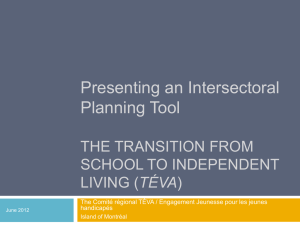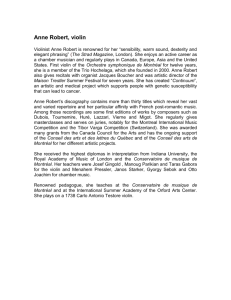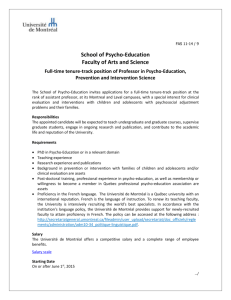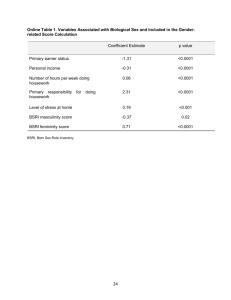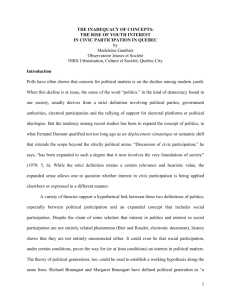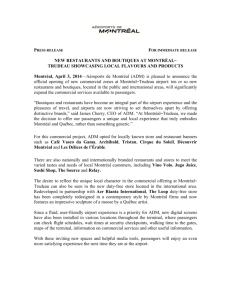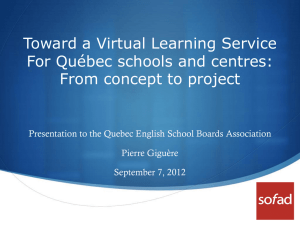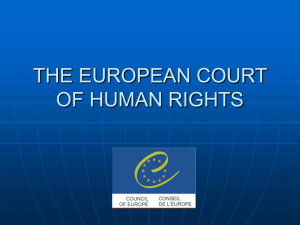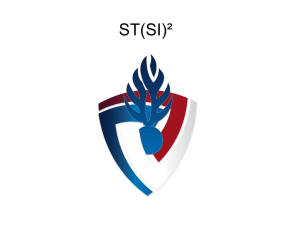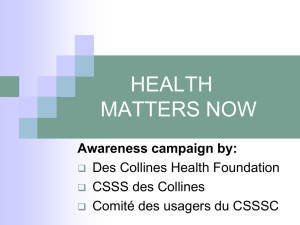Transition école-vie active Un outil de planification
advertisement
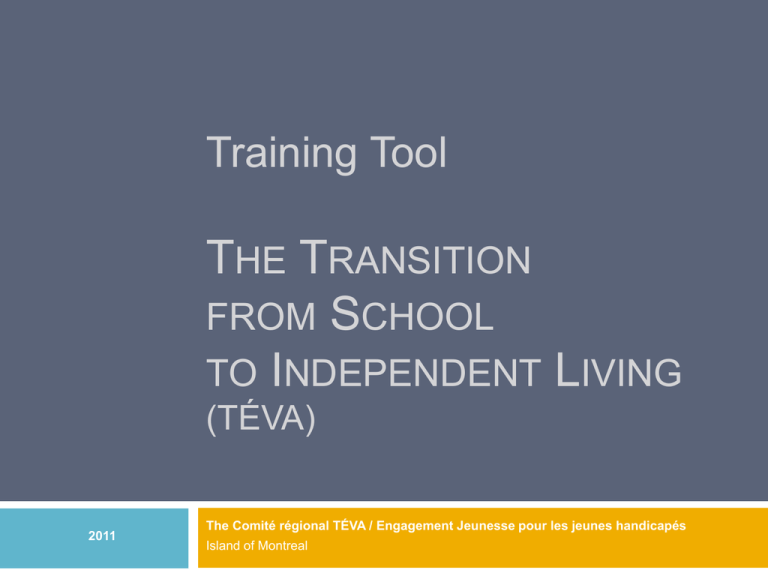
Training Tool THE TRANSITION FROM SCHOOL TO INDEPENDENT LIVING (TÉVA) 2011 The Comité régional TÉVA / Engagement Jeunesse pour les jeunes handicapés Island of Montreal Challenges Faced 2 A young person living with a handicap leaving school faces many challenges, such as how to: find and keep a job pursue post-secondary studies participate in fulfilling activities develop a new social network As a result, we need to… 3 Help young people overcome these challenges and realize their life goals make a world of difference. Create a well-structured plan that includes cooperation between the school and its partners to make the student’s transition to independent living much smoother. Ensure that the student and his/her parents are at the centre of the process. What is Transition from School to Independent Living (TÉVA) 4 Transition Planning is defined as a coordinated and planned set of activities designed to support students so that they can achieve their life goals after they leave school, especially with regard to: entering the workforce; creating new social networks; enjoying recreational activities; participating in the community; pursuing further education and training. Goals of the Transition from School to Independent Living (TÉVA) 5 Develop an individualized approach that helps young people achieve their life goals; Increase the degree to which young people living with a handicap are prepared for adult life by addressing all aspects of independent living; Identify and attempt to reduce obstacles in order to make the transition a smooth one; Develop partnerships to ensure continuity between the school and other services so that these young people do not find themselves lacking necessary services; Encourage complementarity among service partners and promote cooperation between the various networks involved. Legal and Regulatory Framework in Québec 6 In Québec, the transition from school to independent living (TÉVA) is set out in the following documents: Policy on Special Education (La politique d’adaptation scolaire), MELS, 1999 L’Entente de complémentarité MELS-MSSS, 2003 Le cadre de référence pour l’établissement des plans d’intervention, MELS, 2004 Le Plan d’accès aux services pour personnes ayant une déficience, MSSS, 2008 La Stratégie nationale pour l’intégration et le maintien en emploi des personnes handicapées, MESS, 2008 La politique gouvernementale À part entière, 2009 La Stratégie d’action jeunesse 2006-2009 et 2009-2014, Secrétariat à la jeunesse 7 Transition Plans outside of Québec An Alberta policy defines the transition plan as a collaborative plan and process so that the student leaving school attains a better quality of life through workforce integration and independent living. In British Columbia, ministerial directives propose that all transition experiences be planned and coordinated. As such, a transition plan should be put in place two to three years before the student leaves school. In the United States, it is mandatory that transition plans be set up once a student reaches the age of 14, according to the Individual with Disabilities Education Act (IDEA), an American federal law. Target Population 8 Transition planning is aimed at young people who: have physical or intellectual disabilities, pervasive developmental disorders, or mental health disorders; are at least 15 years of age; are attending a secondary school; wish to undertake a transition planning process. These young people need a carefully-planned, concerted process that will ensure a smooth transition to adult life. Putting Transition Planning into Operation 9 The transition plan identifies the student’s life goals and the means of achieving them. It should also include his/her strengths and challenges, interests, leisure activities, etc. The process of transitioning to independence must be laid out in a transition plan that is part of the student’s IEP and of the Individualized Service Plan (PSI), if applicable. Key Players in the Intervention Plan 10 The student, the school principal or his/her representative, the teacher, stakeholders from the health and social services and/or employment sectors involved with the student’s case AND the parents Other possible key players: other school personnel involved with the student; personnel from rehabilitation centres and the CSSS; stakeholders from the employment network; community partners. Responsibilities 11 The role of the school: Put the transition plan in place and begin the transition process; Identify students who would benefit from a transition plan; Establish and maintain contact with parents and organizations involved in the transition plan; Work in cooperation with the student and all other partners to set and attain the goals specified in the transition plan. Responsibilities 12 Partner institutions or organizations must: participate in transition plan meetings when directly involved with the student and share relevant information as required; share in establishing the goals defined in the transition plan, and to that end, assist in attaining goals by making their services available. The Process 13 1. Introduce the overall process of transition planning to the student and his/her parents; 2. Support the student in identifying his/her life goals; 3. Draw up an individualized transition plan with the student; 4. Implement the transition plan; 5. Revise and follow up on the transition plan; 6. Refer the student to new partners or services and share relevant information as needed. Conditions for Success 14 The student must always be at the heart of the process; The student and his/her parents must be active participants in the process; Goals must be set according to the student’s life goals, and not only as a result of the services available; Innovative practices and approaches should be considered; Cooperation between partners from the various networks involved is essential. A Glance Toward the Future 15 Thanks to the efforts and cooperation of numerous partners, these young people are equipped to embark on the challenge of achieving their life goals. Students and their parents are reassured when facing the future and feel supported in the process of transitioning from school to independent living. Members of the Comité régional TÉVA/Engagement jeunesse 2012-2013 16 EDUCATION HEALTH & SOCIAL SERVICES Commission scolaire Marguerite-Bourgeoys Commission scolaire de Montréal Commission scolaire de la Pointe-de-l’Île Direction régionale de Montréal du Ministère de l’Éducation, du Loisir et du Sport English Montreal School Board Lester B. Pearson School Board Regroupement des écoles privées en adaptation scolaire Agence de la santé et des services sociaux de Montréal Centre de réadaptation Lucie-Bruneau Centre de réadaptation Marie-Enfant CRDITED de Montréal CSSS de la Pointe-de-l’Île Office des personnes handicapées du Québec EMPLOYMENT COMMUNITY ORGANIZATIONS Action main-d’œuvre inc. Direction régionale d’Emploi-Québec de l’Îlede-Montréal SPHERE-Québec (Support à la personne handicapée en route vers l’emploi au Québec) AlterGo Comité régional des associations en déficience intellectuelle (CRADI) Regroupement des organismes de promotion du Montréal métropolitain (ROPMM) Réseau alternatif et communautaire des organismes en santé mentale de l’île de Montréal (RACOR) MUNICIPAL RECREATION SERVICES OTHERS Ville de Montréal Engagement jeunesse Montréal 17 Thank you for your attention!
